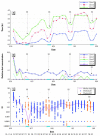Exposures among pregnant women near the World Trade Center site on 11 September 2001
- PMID: 15929898
- PMCID: PMC1257600
- DOI: 10.1289/ehp.7694
Exposures among pregnant women near the World Trade Center site on 11 September 2001
Abstract
We have characterized environmental exposures among 187 women who were pregnant, were at or near the World Trade Center (WTC) on or soon after 11 September 2001, and are enrolled in a prospective cohort study of health effects. Exposures were assessed by estimating time spent in five zones around the WTC and by developing an exposure index (EI) based on plume reconstruction modeling. The daily reconstructed dust levels were correlated with levels of particulate matter < or = 2.5 microm in aerodynamic diameter (PM2.5; r = 0.68) or PM10 (r = 0.73-0.93) reported from 26 September through 8 October 2001 at four of six sites near the WTC whose data we examined. Biomarkers were measured in a subset. Most (71%) of these women were located within eight blocks of the WTC at 0900 hr on 11 September, and 12 women were in one of the two WTC towers. Daily EIs were determined to be highest immediately after 11 September and became much lower but remained highly variable over the next 4 weeks. The weekly summary EI was associated strongly with women's perception of air quality from week 2 to week 4 after the collapse (p < 0.0001). The highest levels of polycyclic aromatic hydrocarbon-deoxyribonucleic acid (PAH-DNA) adducts were seen among women whose blood was collected sooner after 11 September, but levels showed no significant associations with EI or other potential WTC exposure sources. Lead and cobalt in urine were weakly correlated with sigmaEI, but not among samples collected closest to 11 September. Plasma OC levels were low. The median polychlorinated biphenyl level (sum of congeners 118, 138, 153, 180) was 84 ng/g lipid and had a nonsignificant positive association with sigmaEI (p > 0.05). 1,2,3,4,6,7,8-Heptachlorodibenzodioxin levels (median, 30 pg/g lipid) were similar to levels reported in WTC-exposed firefighters but were not associated with EI. This report indicates intense bystander exposure after the WTC collapse and provides information about nonoccupational exposures among a vulnerable population of pregnant women.
Figures



References
-
- Akins JR, Waldrep K, Bernert JT., Jr The estimation of total serum lipids by a completely enzymatic “summation” method. Clin Chim Acta. 1989;184:219–226. - PubMed
-
- Berkowitz GS, Wolff MS, Janevic TM, Holzman IR, Yehuda R, Landrigan PJ. The World Trade Center disaster and intrauterine growth restriction. JAMA. 2003b;290:595–596. - PubMed
-
- Burke JM, Zufall MJ, Ozkaynak H. A population exposure model for particulate matter: case study results for PM(2.5) in Philadelphia, PA. J Expo Anal Environ Epidemiol. 2001;11:470–489. - PubMed
-
- CDC 2003. Second National Report on Human Exposure to Environmental Chemicals. Atlanta, GA:Centers for Disease Control and Prevention. Available: http://www.cdc.gov/exposurereport/2nd/pdf/secondner.pdf [accessed 15 January 2005].
Publication types
MeSH terms
Substances
Grants and funding
LinkOut - more resources
Full Text Sources
Medical

